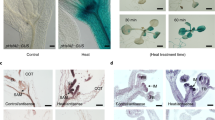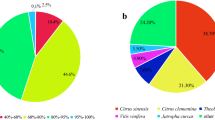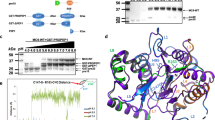Abstract
Phosphorylation at the carboxy-terminal domain of the largest subunit of RNA polymerase II plays a critical role in transcription, and histone acetylation is correlated with active transcription. However, the regulatory mechanisms by which histone acetylation modulates RNA polymerase II phosphorylation in plants remain unclear. Here we show that two functionally redundant bromodomain-containing proteins, global transcription factor group E2 (GTE2) and GTE7, can bind to acetylated histone H4. Both GTE2 and GTE7 interact with cyclin-dependent kinase-like 9 (CDKL9), which belongs to a plant-specific CDKL group. Unlike canonical CDKs, CDKL9 functions in a cyclin- and CDK-activating-kinase-independent manner and can phosphorylate at least the serine 2 and serine 5 residues of the carboxy-terminal domain in vitro. The GTE2/GTE7–CDKL9 complex is required to maintain serine 2 and serine 5 phosphorylation under heat stress. Consistently, loss-of-function gte2/gte7 and cdkl9 mutants show similar heat-sensitive phenotypes. We also demonstrate that the acetylated-histone-binding activity of GTE7 is essential for the association of CDKL9 with chromatin and for plant heat tolerance. Together, these findings provide mechanistic insight into transcriptional regulation via histone acetylation in response to heat stress and suggest that plants might have evolved a unique group of carboxy-terminal domain kinases for stress tolerance.
This is a preview of subscription content, access via your institution
Access options
Access Nature and 54 other Nature Portfolio journals
Get Nature+, our best-value online-access subscription
$32.99 / 30 days
cancel any time
Subscribe to this journal
Receive 12 digital issues and online access to articles
$119.00 per year
only $9.92 per issue
Buy this article
- Purchase on SpringerLink
- Instant access to full article PDF
Prices may be subject to local taxes which are calculated during checkout







Similar content being viewed by others
Data availability
High-throughput sequencing of ChIP and transcriptome data are available on the China National Center for Bioinformation (https://ngdc.cncb.ac.cn/) with the accession number CRA019323. Source data are provided with this paper.
References
Harlen, K. M. & Churchman, L. S. The code and beyond: transcription regulation by the RNA polymerase II carboxy-terminal domain. Nat. Rev. Mol. Cell Biol. 18, 263–273 (2017).
Hajheidari, M., Koncz, C. & Eick, D. Emerging roles for RNA polymerase II CTD in Arabidopsis. Trends Plant Sci. 18, 633–643 (2013).
Nojima, T. et al. RNA polymerase II phosphorylated on CTD serine 5 interacts with the spliceosome during co-transcriptional splicing. Mol. Cell 72, 369–379.e4 (2018).
Schwer, B. & Shuman, S. Deciphering the RNA polymerase II CTD code in fission yeast. Mol. Cell 43, 311–318 (2011).
Licatalosi, D. D. et al. Functional interaction of yeast pre-mRNA 3′ end processing factors with RNA polymerase II. Mol. Cell 9, 1101–1111 (2002).
Malumbres, M. Cyclin-dependent kinases. Genome Biol. 15, 122 (2014).
Akhtar, M. S. et al. TFIIH kinase places bivalent marks on the carboxy-terminal domain of RNA polymerase II. Mol. Cell 34, 387–393 (2009).
Hengartner, C. J. et al. Temporal regulation of RNA polymerase II by Srb10 and Kin28 cyclin-dependent kinases. Mol. Cell 2, 43–53 (1998).
Cramer, P. Eukaryotic transcription turns 50. Cell 179, 808–812 (2019).
Devaiah, B. N. et al. BRD4 is an atypical kinase that phosphorylates serine2 of the RNA polymerase II carboxy-terminal domain. Proc. Natl Acad. Sci. USA 109, 6927–6932 (2012).
Hintermair, C. et al. Threonine-4 of mammalian RNA polymerase II CTD is targeted by Polo-like kinase 3 and required for transcriptional elongation. EMBO J. 31, 2784–2797 (2012).
Cui, X., Fan, B., Scholz, J. & Chen, Z. Roles of Arabidopsis cyclin-dependent kinase C complexes in cauliflower mosaic virus infection, plant growth, and development. Plant Cell 19, 1388–1402 (2007).
Kitsios, G., Alexiou, K. G., Bush, M., Shaw, P. & Doonan, J. H. A cyclin-dependent protein kinase, CDKC2, colocalizes with and modulates the distribution of spliceosomal components in Arabidopsis. Plant J. 54, 220–235 (2008).
Hajheidari, M., Farrona, S., Huettel, B., Koncz, Z. & Koncz, C. CDKF;1 and CDKD protein kinases regulate phosphorylation of serine residues in the C-terminal domain of Arabidopsis RNA polymerase II. Plant Cell 24, 1626–1642 (2012).
Shimotohno, A. et al. Diverse phosphoregulatory mechanisms controlling cyclin-dependent kinase-activating kinases in Arabidopsis. Plant J. 47, 701–710 (2006).
Shimotohno, A., Umeda-Hara, C., Bisova, K., Uchimiya, H. & Umeda, M. The plant-specific kinase CDKF;1 is involved in activating phosphorylation of cyclin-dependent kinase-activating kinases in Arabidopsis. Plant Cell 16, 2954–2966 (2004).
Yun, M., Wu, J., Workman, J. L. & Li, B. Readers of histone modifications. Cell Res. 21, 564–578 (2011).
Yang, Z. et al. Recruitment of P-TEFb for stimulation of transcriptional elongation by the bromodomain protein Brd4. Mol. Cell 19, 535–545 (2005).
Jang, M. K. et al. The bromodomain protein Brd4 is a positive regulatory component of P-TEFb and stimulates RNA polymerase II-dependent transcription. Mol. Cell 19, 523–534 (2005).
Zheng, B. et al. Distinct layers of BRD4–PTEFb reveal bromodomain-independent function in transcriptional regulation. Mol. Cell 83, 2896–2910.e4 (2023).
Bardani, E., Kallemi, P., Tselika, M., Katsarou, K. & Kalantidis, K. Spotlight on plant bromodomain proteins. Biology 12, 1076 (2023).
Airoldi, C. A. et al. The Arabidopsis BET bromodomain factor GTE4 is involved in maintenance of the mitotic cell cycle during plant development. Plant Physiol. 152, 1320–1334 (2010).
Chua, Y. L., Channeliere, S., Mott, E. & Gray, J. C. The bromodomain protein GTE6 controls leaf development in Arabidopsis by histone acetylation at ASYMMETRIC LEAVES1. Genes Dev. 19, 2245–2254 (2005).
Misra, A., McKnight, T. D. & Mandadi, K. K. Bromodomain proteins GTE9 and GTE11 are essential for specific BT2-mediated sugar and ABA responses in Arabidopsis thaliana. Plant Mol. Biol. 96, 393–402 (2018).
Zhou, Q. et al. Bromodomain-containing factor GTE4 regulates Arabidopsis immune response. BMC Biol. 20, 256 (2022).
Soutourina, J. Transcription regulation by the Mediator complex. Nat. Rev. Mol. Cell Biol. 19, 262–274 (2018).
Menges, M., de Jager, S. M., Gruissem, W. & Murray, J. A. Global analysis of the core cell cycle regulators of Arabidopsis identifies novel genes, reveals multiple and highly specific profiles of expression and provides a coherent model for plant cell cycle control. Plant J. 41, 546–566 (2005).
Zheng, Z. L. Cyclin-dependent kinases and CTD phosphatases in cell cycle transcriptional control: conservation across eukaryotic kingdoms and uniqueness to plants. Cells 11, 279 (2022).
Malumbres, M. et al. Cyclin-dependent kinases: a family portrait. Nat. Cell Biol. 11, 1275–1276 (2009).
Park, K. et al. CDKL kinase regulates the length of the ciliary proximal segment. Curr. Biol. 31, 2359–2373.e7 (2021).
Gomi, H., Sassa, T., Thompson, R. F. & Itohara, S. Involvement of cyclin-dependent kinase-like 2 in cognitive function required for contextual and spatial learning in mice. Front Behav. Neurosci. 4, 17 (2010).
Shao, Q. et al. CDKL2 is associated with HER2 status and overall survival in gastric cancer: comparative analysis of CDKL2 protein expression and gene copy number. Biomed. Res. Int. 2020, 1712723 (2020).
Callaway, E. AI protein-prediction tool AlphaFold3 is now more open. Nature 635, 531–532 (2024).
Shogren-Knaak, M. et al. Histone H4-K16 acetylation controls chromatin structure and protein interactions. Science 311, 844–847 (2006).
Taylor, G. C., Eskeland, R., Hekimoglu-Balkan, B., Pradeepa, M. M. & Bickmore, W. A. H4K16 acetylation marks active genes and enhancers of embryonic stem cells, but does not alter chromatin compaction. Genome Res. 23, 2053–2065 (2013).
Dhalluin, C. et al. Structure and ligand of a histone acetyltransferase bromodomain. Nature 399, 491–496 (1999).
Li, C. et al. A review of CDKL: an underestimated protein kinase family. Int. J. Biol. Macromol. 277, 133604 (2024).
Flax, R. G. et al. Illumination of understudied ciliary kinases. Front. Mol. Biosci. 11, 1352781 (2024).
Wang, Z. W., Wu, Z., Raitskin, O., Sun, Q. & Dean, C. Antisense-mediated FLC transcriptional repression requires the P-TEFb transcription elongation factor. Proc. Natl Acad. Sci. USA 111, 7468–7473 (2014).
Zhao, L. et al. Integrative analysis of reference epigenomes in 20 rice varieties. Nat. Commun. 11, 2658 (2020).
Langmead, B. & Salzberg, S. L. Fast gapped-read alignment with Bowtie 2. Nat. Methods 9, 357–359 (2012).
Li, H. et al. The Sequence Alignment/Map format and SAMtools. Bioinformatics 25, 2078–2079 (2009).
Ramírez, F., Dündar, F., Diehl, S., Grüning, B. A. & Manke, T. deepTools: a flexible platform for exploring deep-sequencing data. Nucleic Acids Res. 42, W187–W191 (2014).
Carroll, T. S., Liang, Z., Salama, R., Stark, R. & de Santiago, I. Impact of artifact removal on ChIP quality metrics in ChIP-seq and ChIP-exo data. Front. Genet. 5, 75 (2014).
Zhang, H. B., Kim, M., Chuang, J. H. & Ruan, Y. pyBedGraph: a Python package for fast operations on 1D genomic signal tracks. Bioinformatics 36, 3234–3235 (2020).
Zhang, Y. et al. Model-based Analysis of ChIP-Seq (MACS). Genome Biol. 9, R137 (2008).
Yu, G., Wang, L. G. & He, Q. Y. ChIPseeker: an R/Bioconductor package for ChIP peak annotation, comparison and visualization. Bioinformatics 31, 2382–2383 (2015).
Dobin, A. et al. STAR: ultrafast universal RNA-seq aligner. Bioinformatics 29, 15–21 (2013).
Li, B. & Dewey, C. N. RSEM: accurate transcript quantification from RNA-seq data with or without a reference genome. BMC Bioinform. 12, 323 (2011).
Kassambara, A. & Mundt, F. factoextra: Extract and Visualize the Results of Multivariate Data Analyses. R version 1.0.7 https://CRAN.R-project.org/package=factoextra (2020).
Love, M. I., Huber, W. & Anders, S. Moderated estimation of fold change and dispersion for RNA-seq data with DESeq2. Genome Biol. 15, 550 (2014).
Chen, X. et al. POWERDRESS interacts with HISTONE DEACETYLASE 9 to promote aging in Arabidopsis. eLife 5, e17214 (2016).
Gallo-Oller, G., Ordoñez, R. & Dotor, J. A new background subtraction method for western blot densitometry band quantification through image analysis software. J. Immunol. Methods 457, 1–5 (2018).
Acknowledgements
We thank X. Zhong from Washington University in St Louis and D.-X. Zhou from University Paris-Saclay for their valuable suggestions for this study. We also thank Q. Lu from the Core Facility of the State Key Laboratory of Hybrid Rice at Wuhan University for technical support. This work was supported by the National Key Technologies R&D Program of China (grant no. 2023YFF1002400), the Hubei Provincial Natural Science Foundation (grant nos 2024AFA062 and 2022CFA025) and the National Natural Science Foundation of China (grant no. 32470618).
Author information
Authors and Affiliations
Contributions
X.Z. and X.C. designed the experiments. X.Z. performed most of the experiments. Z.Z. performed all bioinformatic analysis. P.Y., Q.Z. and X.L. provided technical assistance. X.Z. and X.C. analysed the data and wrote the paper. X.C. conceived of and supervised the project. All authors discussed the results and commented on the paper.
Corresponding author
Ethics declarations
Competing interests
The authors declare no competing interests.
Peer review
Peer review information
Nature Plants thanks Tibor Csorba and the other, anonymous, reviewer(s) for their contribution to the peer review of this work.
Additional information
Publisher’s note Springer Nature remains neutral with regard to jurisdictional claims in published maps and institutional affiliations.
Extended data
Extended Data Fig. 1 Phylogenetic analysis of GTE proteins.
a. Phylogenetic tree of bromodomain-containing proteins from Arabidopsis thaliana, Oryza sativa and Homo sapiens. The phylogenetic tree was constructed using MEGA11. b. Phylogenetic tree of Arabidopsis thaliana GTE family members. Diagrams at the right represent the protein structures for each member.
Extended Data Fig. 2 Phylogenetic analysis of CDKs and CDKLs in Arabidopsis thaliana and Homo sapiens.
Phylogenetic tree of CDKs and CDKLs from Arabidopsis thaliana and Homo sapiens. The names with green background are Arabidopsis thaliana CDKLs and yellow background are Homo sapiens CDKLs. The red colored names show Homo sapiens CDKs and CDKLs, and the black colored names show Arabidopsis thaliana CDKs and CDKLs.
Extended Data Fig. 3 In vitro kinase activity assays of CDKL9 and GTE7.
a. The protein structure of CDKL9 was predicted by AlphaFold3. Potential ATP binding sites (196-205) were zoomed in by dashed box. b. In vitro kinase assay of CDKL9 on GTE7. c. In vitro kinase assay of GTE7 on Pol II CTD. The experiments in b and c were repeated independently two times and showed similar results.
Extended Data Fig. 4 Generation and phenotypic analysis of gte2, gte7 and cdkl9 mutants.
a. Diagram of GTE2 and GTE7 genes show the positions of T-DNA insertions. b, c. Confirmation of the gte2 (b) and gte7 (c) T-DNA insertion lines by RT-PCR, MON1 served as internal control. The experiments in b and c were repeated independently two times and showed similar results. d. Diagram of cdkl9 mutant generated by CRISPR-Cas9. e. Confirmation of the cdkl9 mutant by PCR. F and R primers position are shown in (d). The experiments were repeated independently two times and showed similar results. f. Fresh weights of rosette leaves of WT, gte2, gte7, gte2/7 and GTE7/gte2gte7 plants. Each circle represents an individual plant. Data are presented as mean ± s.e.m. Significance was evaluated by a one-way analysis of variance. Different letters indicate significant differences tested by Tukey’s multiple range test (P < 0.05). F represents the ratio of between-group variance to within-group variance, df indicates degrees of freedom between groups, and P denotes the probability of observing the effect under the null hypothesis. g. Fresh weights of rosette leaves of cdkl9, gte2/7 and cdkl9 gte2/7 mutants. Each circle represents an individual plant. Data are presented as mean ± s.e.m. Significance was evaluated in the same way as in (f).
Extended Data Fig. 5 Phenotypic and protein level analysis of gte2/7, cdkl9 mutants and rescued plants.
a-d. Vann diagrams show the overlapped genes with decreased Ser2P (a) or Ser5P (c) and increased Ser2P (b) or Ser5P (d) in gte2/7 or cdkl9 under normal condition. e. The seed germination rate of WT, gte2/7 and GTE7/gte2gte7 on CK, 200 mM NaCl, 350 mM Mannitol and 4°C. Data are presented as mean ± s.e.m. (n = 3 biological replicates). f. The seed germination phenotypes of WT, gte2/7 and GTE7/gte2gte7 under heat stress. g. Quantifications of the relative germination rate for each genotype presented in (f) after heat stress. Data are presented as mean ± s.e.m. (n = 12 biological replicates). P values are calculated by two-tailed Student’s t test. h, i. Vann diagrams show the overlapped genes with increased Ser2P (h) or Ser5P (i) in gte2/7 or cdkl9 under heat condition. j. Protein levels of GTE2-HA, GTE7-HA and CDKL9-HA under normal and Heat conditions. ACTIN served as control. The experiments were repeated independently two times and showed similar results.
Extended Data Fig. 6 Transcriptomic analysis of WT, gte2/7 and cdkl9 mutants under normal and heat conditions.
a. Principal component analysis (PCA) of RNA-seq data in WT, gte2/7 and cdkl9 under normal condition. b. Volcano plots showing differentially expressed genes in gte2/7 or cdkl9 compared with WT under normal condition. P values are calculated using two-tailed Wald tests under negative binomial generalized linear models, with 95% confidence intervals derived from normal approximation. c. Principal component analysis (PCA) of RNA-seq data in WT, gte2/7 and cdkl9 under heat condition. d. Volcano plots showing differentially expressed genes in gte2/7 or cdkl9 compared with WT under heat condition. P values are calculated using two-tailed Wald tests under negative binomial generalized linear models, with 95% confidence intervals derived from normal approximation. e. Expression levels of the 95 genes overlapped (Fig. 4c) in WT, gte2/7 and cdkl9 under normal and heat condition. P values were calculated by two-tailed Student’s t test. Each plotting panel, from left to right, displays the frequency distribution of the data, the boxplot, and the raw data points. In the boxplot, the central horizontal line within the box represents the median of the data. The upper edge of the box corresponds to the upper quartile, while the lower edge indicates the lower quartile. The whiskers extend to the minimum and maximum values within 1.5 times the interquartile range.
Extended Data Fig. 7 Chromatin associations of GTE2, GTE7 and CDKL9.
a, b. Chromosomal views of GTE2 and GTE7 under normal (a) and heat (b) condition distribution on five chromosomes. The Y-axis represents the log2 value of GTE2-HA and GTE7-HA ChIP-seq reads relative to untagged WT control. Chr1, Chr2, Chr3, Chr4 and Chr5 represent chromosomes 1 to 5, respectively. Black triangles indicate the location of centromeric regions. c. Metaplots and heatmaps show the distribution patterns of GTE2 and GTE7 protein on all genes. TSS, transcription start site; TES, transcription end site; −2 and 2 kb represent 2 kb upstream of TSS and 2 kb downstream TES, respectively. d. Additional biological replicate for Fig. 5p showing ChIP-quantitative PCR (ChIP-qPCR) analysis for CDKL9 enrichment under normal and heat condition on representative genes (n = 2 technical replicates). e, f. ChIP-quantitative PCR (ChIP-qPCR) analysis of CDKL9 enrichment under normal and heat condition on representative genes chosen from the GTE2 and GTE7 bound genes (n = 2 technical replicates). e and f represent two biological replicates.
Extended Data Fig. 8 Sequence and functional analysis of histone acetylation-binding activity of GTE7.
a. Sequence alignment of bromodomains of GTE2, GTE7, BRD4, CBP, P300 and PCAF. Two conserved residues of Tyr and Asn are shown in red box. b. Metaplots show the GTE7 and GTE72A enrichment level on GTE2/7-enriched genes under heat condition. c. Additional biological replicate for Fig. 7a showing ChIP-qPCR analysis of CDKL9 enrichment on genes in wild-type and gte2/7 mutant backgrounds (n = 2 technical replicates). d. Additional biological replicate for Fig. 7b showing ChIP-qPCR analysis of CDKL9 enrichment on genes in wild-type and GTE72A-rescued gte2/7 mutant backgrounds (n = 2 technical replicates).
Supplementary information
Supplementary Information
Supplementary Fig. 1.
Supplementary Tables
Supplementary Tables 1–11.
Source data
Source Data Figs. 1, 2, 4 and 6 and Extended Data Figs. 3–5
Combined figure of the unprocessed scanned pictures for all the blots.
Rights and permissions
Springer Nature or its licensor (e.g. a society or other partner) holds exclusive rights to this article under a publishing agreement with the author(s) or other rightsholder(s); author self-archiving of the accepted manuscript version of this article is solely governed by the terms of such publishing agreement and applicable law.
About this article
Cite this article
Zheng, X., Zuo, Z., Yao, P. et al. Bromodomain-containing proteins interact with a non-canonical RNA polymerase II kinase to maintain gene expression upon heat stress. Nat. Plants 11, 1416–1428 (2025). https://doi.org/10.1038/s41477-025-02044-3
Received:
Accepted:
Published:
Issue date:
DOI: https://doi.org/10.1038/s41477-025-02044-3



